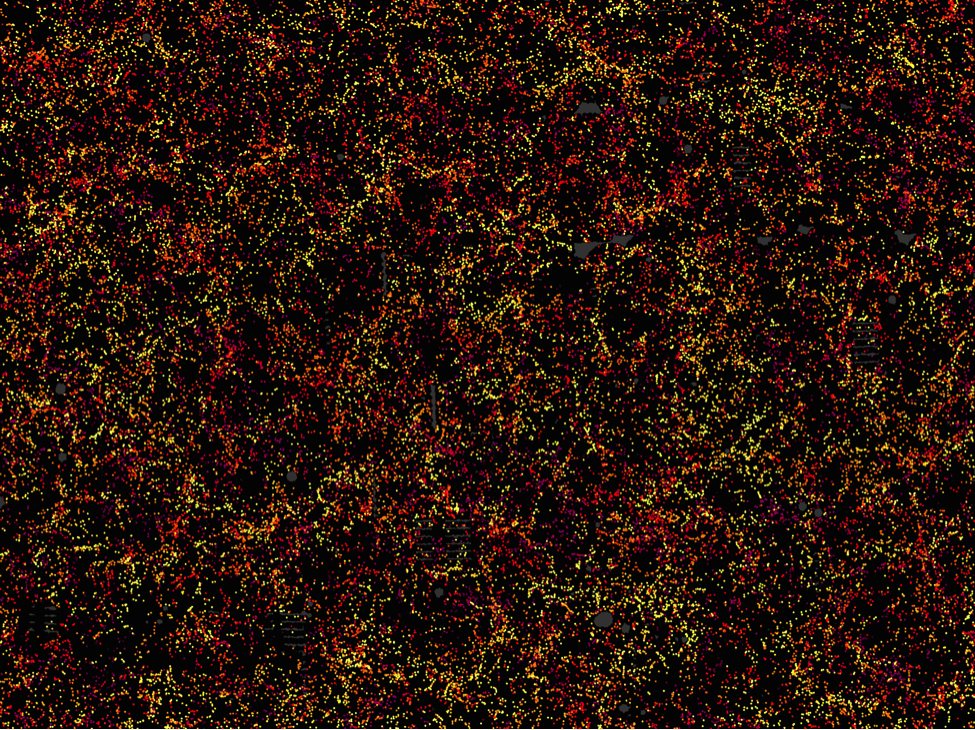1.2 Million Galaxies Dot Largest Ever 3D Map

If you're a space traveler lost in the universe, a team of astronomers here on Earth has your back: They've made the largest ever 3D map of galaxies that humanity can see.
Hundreds of physicists and astronomers gathered data from sky surveys over the course of five years to build the map, which covers about one-quarter of the sky. Called the Baryon Oscillation Spectroscopic Survey (BOSS) program of the Sloan Digital Sky Survey III, the project measured 1.2 million galaxies covering a volume of 650 cubic billion light-years, New York University researcher Jeremy Tinker said in a statement. Tinker co-lead the project's scientific team.
BOSS allowed the scientists to observe the three-dimensional distribution of galaxies in the universe, and also to measure how fast the universe is expanding.
To measure expansion, BOSS looks at the size of pressure waves that traveled across the universe up to when it was only 400,000 years old, a small fraction of its current 13.8-billion-year age. Since that time, evidence of those pressure waves, called baryonic acoustic oscillations (BAOs), has been "frozen" into the visible distribution of matter. This created a pattern in which galaxies tend to be separated by a certain distance most of the time.
By measuring that characteristic distance, as well as the distribution of galaxies as it has changed over the history of the universe, scientists can calculate how gravity from dark matter and the repulsive effects of dark energy have acted together to control the speed of the universe's expansion.
This also lets astronomers test just how accurate Einstein's theory of general relativity is. So far, the famous theory has survived almost everything that's been thrown at it. But many scientists think the theory is not complete, and that there might be areas where it doesn't describe phenomena as well as it has so far, largely because the connection between gravity and quantum mechanics is still a mystery.
Speaking of which, the map shows that galaxies are moving toward parts of the universe with more matter, just as expected given the attractive force of gravity. So far, general relativity seems to be right, according to David Schlegel, an astrophysicist at Lawrence Berkeley National Laboratory, quoted in the release.
Breaking space news, the latest updates on rocket launches, skywatching events and more!
The new results were detailed this month in a series of papers submitted to the journal Monthly Notices of the Royal Astronomical Society.
You can follow Space.com on Twitter @Spacedotcom. We're also on Facebook & Google+. Originally published on Space.com.
Join our Space Forums to keep talking space on the latest missions, night sky and more! And if you have a news tip, correction or comment, let us know at: community@space.com.

Jesse Emspak is a freelance journalist who has contributed to several publications, including Space.com, Scientific American, New Scientist, Smithsonian.com and Undark. He focuses on physics and cool technologies but has been known to write about the odder stories of human health and science as it relates to culture. Jesse has a Master of Arts from the University of California, Berkeley School of Journalism, and a Bachelor of Arts from the University of Rochester. Jesse spent years covering finance and cut his teeth at local newspapers, working local politics and police beats. Jesse likes to stay active and holds a fourth degree black belt in Karate, which just means he now knows how much he has to learn and the importance of good teaching.
